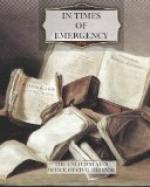If the patient has headache or general discomfort, give him one or two aspirin tablets every 3 or 4 hours (half a tablet, for a child under 12). If he is nauseous, give him “motion sickness tablets,” if available. If his mouth is sore or his gums are bleeding, have him use a mouth wash made up of a half-teaspoonful of salt to 1 quart of water. If there is vomiting or diarrhea, he should drink slowly several glasses each day of a salt-and-soda solution (one teaspoonful of salt and one-half teaspoonful of baking soda to 1 quart of cool water), plus bouillon or fruit juices. If available, a mixture of kaolin and pectin should be given for diarrhea. Whatever his symptoms, the patient should be kept lying down, comfortably warm, and resting.
Remember that radiation sickness is not contagious or infectious, and one person cannot “catch it” from another person.
* * * * *
PART TWO
MAJOR NATURAL DISASTERS
Many of the actions recommended in Part I of this handbook to help you prepare for and live through a nuclear attack—such as learning the warning signals, stocking emergency supplies, taking a course in emergency skills, and knowing how to fight fires at home—also would help you in case a major natural disaster occurs in your area. If you are prepared for nuclear attack, you are also prepared to cope with most peacetime disasters—disasters that kill hundreds of Americans every year, injure thousands, inflict widespread suffering and hardship, and cause great economic loss.
Part II of this handbook (pages 69-86) is intended to help you prepare for those natural disasters that may occur in your area, and tell you the right actions to take if they occur. Chapter 1 (pages 71-74) gives general guidance applicable to various types of natural disasters. Succeeding chapters give special advice on floods, hurricanes, tornadoes, winter storms, and earthquakes.
* * * * *
CHAPTER 1
GENERAL GUIDANCE
There are certain things you can learn and do that will help you get ready for, and cope with, almost any type of natural disaster.
Perhaps the most basic thing to remember is to keep calm. This may mean the difference between life and death. In many disasters, people have been killed or injured needlessly because they took thoughtless actions when they should have done something else—or done nothing at all just then.
In a time of emergency, taking proper action may save your life. Take time to think, and then take the considered action that the situation calls for. Usually, this will be the action you have planned in advance, or the action you are instructed to take by responsible authorities.
Here is other guidance that applies to most types of natural disasters.




